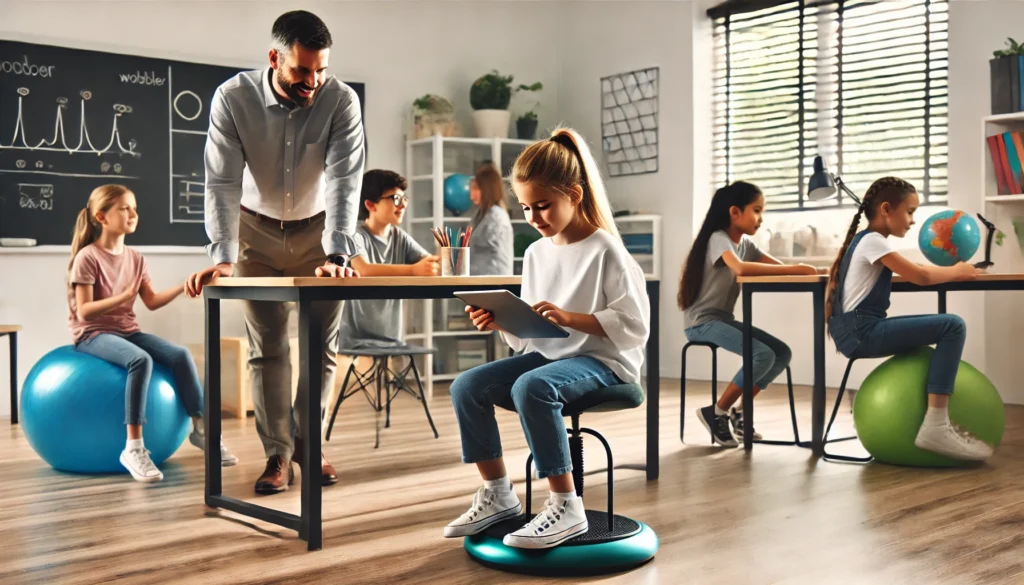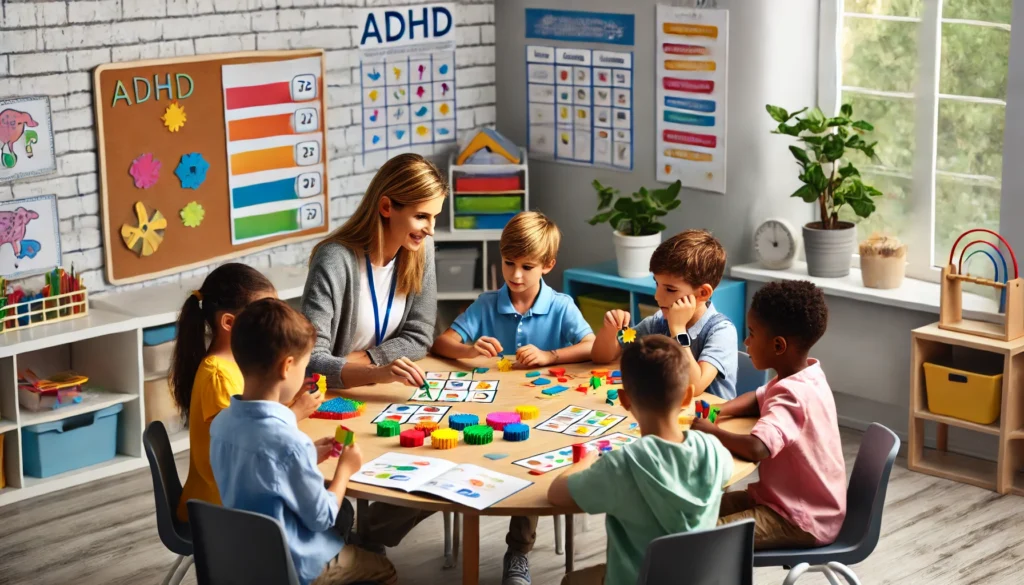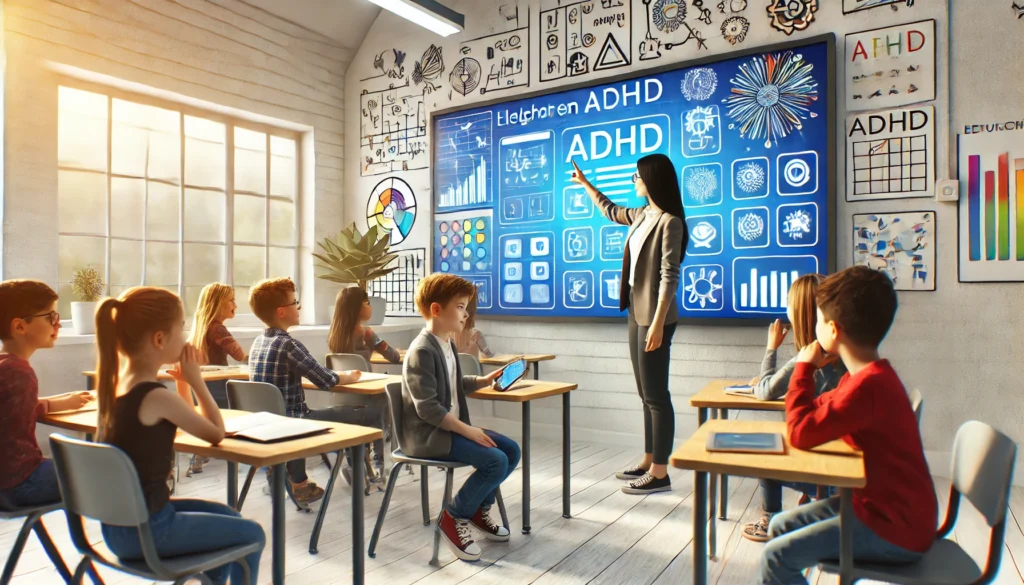Attention Deficit Hyperactivity Disorder (ADHD) is a prevalent neurodevelopmental disorder that affects many children and adults worldwide. As educators, understanding the unique characteristics of ADHD students in the classroom is crucial for fostering an inclusive and effective learning environment. This article delves into the engaging teaching techniques tailored specifically for ADHD learners, offering insights and strategies to enhance their educational experience.
You may also like: Enhancing Concentration: Strategies for ADHD
Understanding ADHD in the Classroom
ADHD is characterized by persistent patterns of inattention, hyperactivity, and impulsivity that interfere with functioning or development. In the classroom, ADHD students often exhibit behaviors that can be misinterpreted as disinterest or defiance. However, these behaviors are typically a manifestation of the disorder, necessitating a compassionate and strategic approach from educators.
Characteristics of ADHD Students in the Classroom
Inattention
Students with ADHD may struggle to maintain focus on tasks or instructions. This inattention is not due to laziness or lack of interest but rather an inability to filter out distractions. They might find it hard to follow multi-step instructions or complete assignments, often appearing to daydream or seem off-task. Recognizing this as a symptom rather than a choice is crucial for educators.
Hyperactivity
Hyperactivity in ADHD students often manifests as an inability to sit still. They might fidget, tap their feet, or move around the classroom more than their peers. Excessive talking or making noises can also be common, not as a form of disruption but as an outlet for their abundant energy. Understanding this behavior helps in creating strategies that accommodate their need for movement.
Impulsivity
Impulsivity can lead ADHD students to act without thinking, interrupting lessons or conversations. They may blurt out answers or struggle to wait their turn, which can be mistaken for rudeness or lack of discipline. Educators can use structured activities that channel impulsivity positively, like quick-response games or timed tasks.
The Emotional and Social Impact
ADHD not only affects academic performance but also has social and emotional implications. Students may feel isolated or misunderstood, leading to low self-esteem. Building a supportive classroom environment that promotes positive interactions and understanding among all students can mitigate these effects. Encouraging peer support and fostering empathy are key strategies.
Strategies for Building Empathy
Educators can facilitate empathy by educating the entire class about ADHD and its effects. Activities that simulate the ADHD experience can help peers understand the challenges their classmates face. This approach not only builds empathy but also creates an inclusive environment where differences are respected and celebrated.

Historical Context and Current Trends in ADHD Education
Historically, ADHD was often misunderstood, with students labeled as “troublemakers” or “lazy.” Over the decades, research has provided a clearer understanding of ADHD as a legitimate neurodevelopmental disorder, leading to more informed educational practices.
Evolution of ADHD Understanding
In the past, ADHD was largely misunderstood and stigmatized. Early educational systems often lacked the resources and knowledge to address the unique needs of ADHD students. However, as research progressed, the perception of ADHD shifted from a behavioral issue to a neurodevelopmental disorder, leading to more compassionate and effective educational approaches.
The Shift Towards Inclusive Education
Recent years have seen a significant shift towards personalized and inclusive teaching methods. This approach involves recognizing the strengths and challenges of ADHD learners and adapting teaching styles to meet their needs. The emphasis is on creating a supportive environment that values diversity and promotes success for all students.
Integration of Technology
Technology has become a powerful tool in ADHD education, offering innovative ways to engage students. From interactive apps to virtual reality, these tools provide dynamic learning experiences that capture the attention of ADHD students. This trend reflects a broader move towards integrating technology to enhance educational outcomes.
Educational Policies and ADHD
Educational policies have increasingly focused on accommodating diverse learning needs, including those of ADHD students. Policies now emphasize differentiated instruction, which tailors teaching methods to individual learning styles. This approach ensures that ADHD students receive the support they need to succeed academically and socially.

Engaging Teaching Techniques for ADHD Learners
1. Structured and Predictable Environment
Creating a structured environment with clear routines and expectations can significantly benefit ADHD students. Predictability helps reduce anxiety and allows students to focus on learning rather than navigating an unpredictable environment.
Visual Schedules
Visual schedules can be an effective way to provide structure. Using charts or digital tools to outline daily activities helps ADHD students understand what to expect and when. These visual aids can also serve as reminders, helping students stay on track with tasks and transitions.
Consistent Routines
Maintaining a consistent order of activities and transitions creates a sense of security for ADHD students. When they know what to expect, it reduces anxiety and allows them to focus more on learning. Educators can develop routines that incorporate regular check-ins and feedback, providing students with a stable framework.
Clear Expectations
Setting clear expectations and boundaries helps ADHD students understand what is required of them. This clarity can prevent misunderstandings and reduce impulsive behavior. Teachers can use simple, direct language to communicate expectations, reinforcing them with visual aids or written instructions.
2. Interactive and Hands-On Learning
ADHD students often thrive in environments that engage their senses and allow for active participation.
Kinesthetic Activities
Incorporating movement into lessons can greatly benefit ADHD students. Activities like role-playing, experiments, or physical games allow them to engage physically and mentally. These kinesthetic approaches make learning more dynamic and memorable, catering to the active nature of ADHD learners.
Interactive Technology
Educational apps and digital tools that offer interactive learning experiences can capture the interest of ADHD students. These technologies provide opportunities for hands-on exploration and immediate feedback, making learning engaging and motivating. Teachers can use gamified learning platforms to enhance participation and understanding.
Sensory Engagement
Engaging multiple senses in the learning process can help ADHD students retain information better. Using materials that involve touch, sound, and movement can make lessons more interesting. For example, using manipulatives in math or sound effects in storytelling can create a rich learning experience.
3. Break Tasks into Manageable Chunks
Long or complex tasks can be overwhelming for ADHD learners. Breaking them into smaller, manageable parts can make them more achievable.
Chunking Techniques
Dividing tasks into smaller segments with clear, step-by-step instructions helps ADHD students manage their workload. This approach makes large projects feel less daunting and improves focus. Educators can use checklists or visual representations to help students track their progress.
Frequent Breaks
Allowing short breaks between tasks helps maintain focus and reduce fatigue. These breaks provide an opportunity for students to recharge and return to work with renewed energy. Teachers can schedule movement breaks or use relaxation techniques to support students‘ concentration.
Incremental Goal Setting
Setting small, attainable goals within tasks can motivate ADHD students by providing a sense of achievement. Breaking tasks into goals and celebrating each success encourages persistence and builds confidence. Educators can use goal-setting as a tool to help students manage time and prioritize tasks.
4. Positive Reinforcement and Encouragement
Positive reinforcement can be a powerful motivator for ADHD students, helping to build self-esteem and encourage desirable behaviors.
Immediate Feedback
Offering immediate praise or rewards for effort and achievement reinforces positive behavior. This feedback helps students understand the connection between their actions and outcomes. Teachers can use verbal praise, stickers, or points systems to acknowledge student efforts promptly.
Personalized Rewards
Tailoring rewards to individual interests can increase motivation for ADHD students. Understanding what motivates each student allows educators to use rewards effectively, encouraging continued effort and improvement. Teachers can involve students in choosing their rewards, making the process more engaging.
Encouraging Self-Esteem
Building self-esteem is crucial for ADHD students, who may struggle with confidence. Positive reinforcement not only promotes desirable behaviors but also helps students recognize their strengths and potential. Educators can create opportunities for students to showcase their talents and receive positive recognition.
5. Flexible Seating Arrangements
Providing options for seating can help ADHD students find a space where they are most comfortable and focused.
Choice Seating
Allowing students to choose between traditional desks, standing desks, or floor seating with cushions offers flexibility. This choice empowers students to select environments where they feel most comfortable and focused. Teachers can rotate seating arrangements to accommodate different preferences and needs.
Movement-Friendly Furniture
Using wobble chairs or balance balls allows for subtle movement, which can help ADHD students maintain focus. These furniture options provide an outlet for energy while keeping students engaged in learning. Educators can introduce these alternatives gradually, observing their impact on student concentration.
Creating Quiet Zones
Designating quiet zones within the classroom can benefit students who need a calm environment to focus. These areas can be equipped with noise-canceling headphones or privacy dividers. Providing a space for students to retreat when feeling overwhelmed encourages self-regulation and concentration.

Future Implications and Innovations in ADHD Education
As research into ADHD continues to evolve, so do the methods for supporting ADHD learners. Emerging technologies and educational innovations hold promise for even more effective teaching strategies.
Technology-Enhanced Learning
Virtual reality (VR) and augmented reality (AR) offer immersive learning experiences that can capture the attention of ADHD students and provide unique ways to explore complex concepts.
Virtual Reality in Education
VR technology enables students to engage with content in a fully immersive environment. This can be particularly beneficial for ADHD learners, offering an engaging way to explore subjects that might otherwise seem abstract. Educators can use VR to simulate real-world scenarios, enhancing understanding and retention.
Augmented Reality Applications
AR allows for interactive exploration of subjects by overlaying digital information onto the physical world. This technology can make learning more interactive and stimulating for ADHD students. Teachers can use AR apps to bring textbooks to life, providing visual and auditory enhancements to traditional learning materials.
Gamification of Learning
Integrating game elements into educational activities can increase motivation and engagement for ADHD learners. Gamification involves using points, badges, and leaderboards to encourage participation and achievement. This approach can transform mundane tasks into exciting challenges, promoting sustained interest.
Personalized Learning Plans
Advancements in data analytics enable the creation of highly personalized learning plans that adapt to the individual needs and progress of each student.
Data-Driven Insights
Using data analytics, educators can gain insights into the learning patterns and needs of ADHD students. This information allows for the development of tailored learning plans that address specific challenges and leverage strengths. Teachers can use these insights to adjust instructional strategies and resources.
Adaptive Learning Technologies
Adaptive learning platforms use algorithms to adjust content and pace based on student performance. This personalization helps ADHD students learn at their own pace, ensuring they fully understand concepts before moving on. Educators can incorporate these technologies to provide individualized support and feedback.
Continuous Assessment and Feedback
Regular assessment and feedback are crucial for monitoring the progress of ADHD students. Continuous assessment allows for timely identification of areas needing improvement, while feedback provides guidance and encouragement. Teachers can use formative assessments to track student growth and adjust instruction accordingly.
Collaborative and Inclusive Practices
Fostering a collaborative environment where educators, parents, and students work together can enhance the educational experience for ADHD learners. Inclusive practices that value diversity and promote understanding can help create a supportive community for all students.
Building Strong Partnerships
Collaborating with parents and caregivers is essential for supporting ADHD students. Open communication and shared goals help ensure consistency between home and school environments. Educators can organize regular meetings and provide resources to empower parents in supporting their children’s learning.
Promoting Peer Support
Encouraging peer support and collaboration can foster a sense of belonging for ADHD students. Group activities and cooperative learning opportunities allow students to develop social skills and form positive relationships. Teachers can create a classroom culture that values teamwork and mutual respect.
Inclusive Classroom Practices
Implementing inclusive practices involves recognizing and accommodating diverse learning needs. This approach benefits all students, creating a learning environment where everyone feels valued and supported. Educators can use differentiated instruction and universal design principles to promote inclusivity.
Conclusion
Engaging teaching techniques for ADHD learners require a combination of empathy, creativity, and adaptability. By understanding the unique characteristics of ADHD students and implementing tailored strategies, educators can create a classroom environment that not only supports their academic success but also nurtures their personal growth. As we continue to explore and adopt innovative approaches, the future of ADHD education looks promising, offering new opportunities to empower and engage learners with ADHD.
By weaving historical insights, current trends, and future implications, this article aims to provide a comprehensive overview of effective teaching techniques for ADHD learners, equipping educators with the tools they need to make a positive impact in the classroom.
Further Reading:
ADHD in the Classroom: Helping Children Succeed in School
Positive, Intentional Supports for Students With ADHD
Teaching Strategies for Students with ADHD: Ideas to Help Every Child Shine
Important Note: The information contained in this article is for general informational purposes only, and should not be construed as health or medical advice, nor is it intended to diagnose, prevent, treat, or cure any disease or health condition. Before embarking on any diet, fitness regimen, or program of nutritional supplementation, it is advisable to consult your healthcare professional in order to determine its safety and probable efficacy in terms of your individual state of health.
Regarding Nutritional Supplements Or Other Non-Prescription Health Products: If any nutritional supplements or other non-prescription health products are mentioned in the foregoing article, any claims or statements made about them have not been evaluated by the U.S. Food and Drug Administration, and such nutritional supplements or other health products are not intended to diagnose, treat, cure, or prevent any disease.


